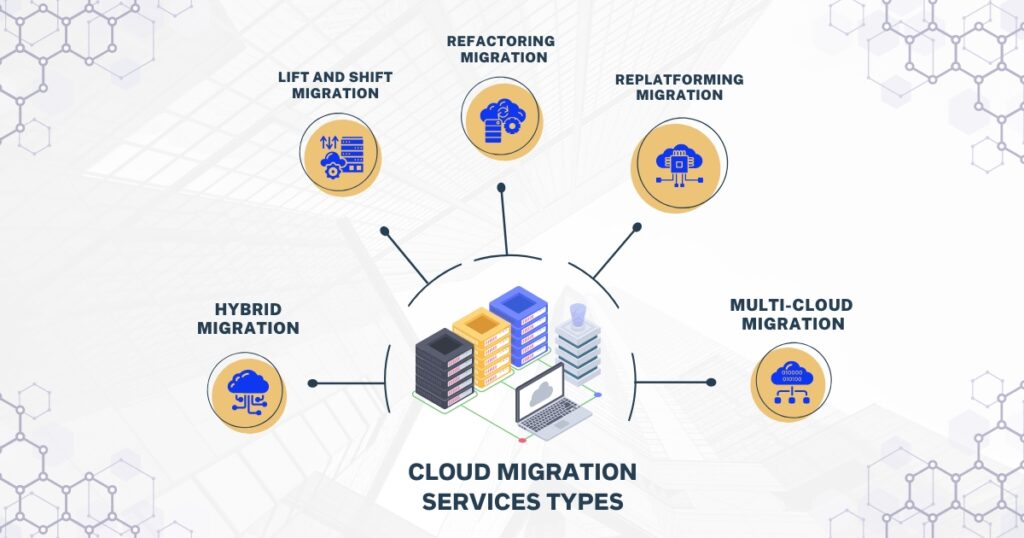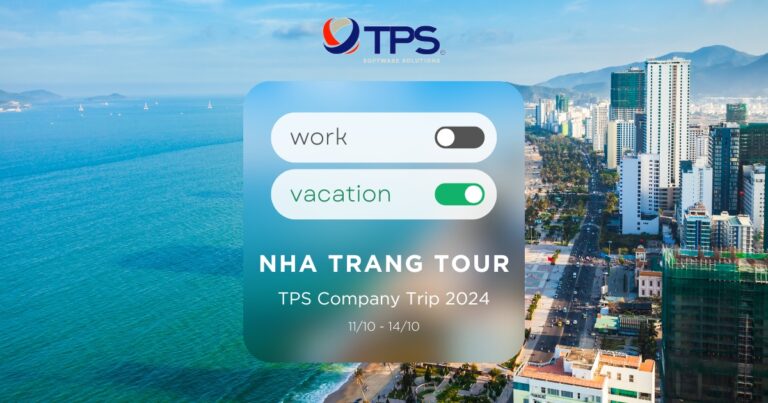What is Cloud Migration Services
Cloud migration services refer to the process of moving an organization’s data, applications, and other business elements from on-premises infrastructure to the cloud. The aim of cloud migration is to leverage the benefits of the cloud, such as scalability, flexibility, cost savings, and better security.
A cloud migration service may involve several steps, including planning, assessment, data migration, application migration, and post-migration testing. The migration process can be complex, and it often requires specialized expertise and tools to ensure a smooth transition.
Cloud migration services may be provided by cloud service providers or third-party cloud migration specialists. They can help organizations determine which applications and workloads are suitable for the cloud, create a migration plan, and execute the migration with minimal downtime and disruption to business operations.
How many types of cloud migration service
There are several types of cloud migration services available.
The type of migration service used will depend on the organization’s goals, budget, and specific needs including:
Lift and Shift Migration: This involves moving an application or workload from on-premises infrastructure to a cloud-based infrastructure without making significant changes to the application architecture.
Replatforming Migration: This involves making some changes to the application architecture to optimize it for the cloud environment. The application may be redesigned to take advantage of cloud-specific services and features.
Refactoring Migration: This involves significant changes to the application architecture to modernize the application and take advantage of cloud-native features.
Hybrid Migration: This involves a combination of on-premises and cloud infrastructure, allowing for a gradual migration of applications and workloads.
Multi-Cloud Migration: This involves moving applications and workloads to multiple cloud providers, enabling organizations to take advantage of different cloud services and avoid vendor lock-in.

What are steps and strategy used in cloud migration service
Steps
Cloud migration refers to the process of moving an organization’s digital assets, such as applications, data, and IT infrastructure, from an on-premises environment to a cloud-based infrastructure. Here are the steps and strategies involved in cloud migration:
- Assessing the current environment: The first step is to evaluate the current IT infrastructure and identify the applications and data that need to be migrated to the cloud.
- Choosing a cloud provider: The next step is to choose a cloud service provider (CSP) that best fits the organization’s needs. This decision should be based on factors such as cost, scalability, security, and the type of services offered by the CSP.
- Selecting a migration strategy: Organizations need to determine the most suitable migration strategy based on their needs and budget. The most common strategies include rehosting, refactoring, rearchitecting, and rebuilding.
- Preparing for migration: This involves identifying and addressing any potential issues that may arise during migration, such as security risks, compliance requirements, and data protection.
- Testing and validating the migration: Before the actual migration, organizations should test the migration process on a smaller scale and validate that the data and applications work as expected in the cloud environment.
- Executing the migration: Once the organization is ready, they can start the migration process. This may involve transferring data, applications, and configurations to the cloud infrastructure.
- Monitoring and optimizing the cloud environment: After the migration, organizations should continue to monitor the cloud environment to ensure that it is functioning as expected. This includes managing security, performance, and costs.
Strategies
- Building a strong team: A successful cloud migration requires a team of skilled professionals who have experience with cloud migration and are familiar with the chosen CSP.
- Adopting a phased approach: Organizations should adopt a phased approach to cloud migration and prioritize critical applications and data.
- Automating the migration process: Automation can speed up the migration process and reduce the risk of errors.
- Ensuring data security: Organizations should ensure that their data is secure during the migration process and in the cloud environment.
- Planning for ongoing maintenance: Organizations should plan for ongoing maintenance and optimization of the cloud environment to ensure its performance and cost-effectiveness.
What are common tools ?
There are many cloud migration tools available, and the most common ones vary depending on the specific needs and requirements of the migration project. However, here are some of the most widely used cloud migration tools:
- AWS Database Migration Service (DMS): A service provided by Amazon Web Services (AWS) that helps migrate databases to AWS quickly and securely.
- Azure Site Recovery: A disaster recovery service provided by Microsoft Azure that helps migrate on-premises virtual machines, physical servers, and applications to Azure.
- Google Cloud Migrate for Compute Engine: A service provided by Google Cloud Platform (GCP) that helps migrate virtual machines and physical servers to GCP.
- CloudEndure Migration: A migration tool that automates the migration of physical, virtual, and cloud-based servers to AWS, Azure, and GCP.
- Cloudsfer: A cloud data migration tool that supports migration to and from a wide range of cloud storage providers, including AWS, Azure, and GCP.
- Cloudamize: A cloud migration assessment tool that helps businesses analyze their existing IT infrastructure, applications, and workloads to determine their readiness for migration to the cloud.
- Carbonite Migrate: A cloud migration tool that supports the migration of workloads to AWS, Azure, and GCP.
- RiverMeadow: A cloud migration tool that supports the migration of virtual and physical servers to AWS, Azure, and GCP.
- Turbonomic: A cloud migration tool that helps businesses optimize their cloud environment and migrate workloads to the cloud.
- Cloudscape: A cloud migration assessment tool that helps businesses assess their cloud readiness and plan their migration to the cloud.
Note that this is not an exhaustive list, and there are many other cloud migration tools available. The specific tools used for a cloud migration project will depend on the specific needs and requirements of the project.
Benefits of Cloud Migration Services
Scalability: One of the most significant benefits of cloud migration services is the ability to scale resources up or down as needed. This means that organizations can quickly adapt to changing business needs, without having to make significant investments in additional infrastructure.
Cost savings: Cloud migration services can reduce costs associated with maintaining and upgrading on-premises infrastructure, as well as reduce the need for a large IT team. Cloud providers offer pay-as-you-go pricing models, which means organizations only pay for the resources they use.
Flexibility: Cloud migration services allow organizations to access their digital assets from anywhere, as long as they have an internet connection. This enables remote work and collaboration among teams in different locations.
Increased Security: Cloud providers typically have robust security measures in place to protect their infrastructure, which can help organizations better protect their digital assets from cyber threats. Additionally, cloud providers may offer compliance certifications that can help organizations meet regulatory requirements.
Improved Performance: Cloud migration services can improve application performance, as cloud providers typically have faster and more reliable infrastructure than on-premises solutions.
What kind of business needs the services ?
Many businesses can benefit from cloud migration services, especially those that require scalable and cost-effective solutions. Some common examples include:
- Small and medium-sized businesses (SMBs) that want to move from traditional on-premises infrastructure to the cloud to reduce costs and improve flexibility.
Startups that want to take advantage of the cloud’s scalability and agility to rapidly deploy new applications and services. - Large enterprises that need to modernize their legacy systems and improve their ability to innovate.
- E-commerce businesses that require high availability and scalability to support their growing customer base.
- Healthcare organizations that need to store and process large amounts of patient data while complying with regulatory requirements.
- Financial services companies that need to ensure the security and reliability of their systems while complying with strict regulatory requirements.
Frequently Asked Questions
Q: Can I migrate all of my existing applications to the cloud?
A: It depends on the application and its compatibility with cloud infrastructure. Some legacy applications may not be compatible with cloud platforms, while others may require significant modifications to work in the cloud. It’s important to assess each application’s compatibility and plan accordingly.
Q: How can I ensure the security of my data during the migration process?
A: Cloud migration service providers typically have robust security protocols in place to protect your data during the migration process. However, it’s still important to encrypt sensitive data and use secure connections to transfer data to the cloud. Additionally, it’s important to thoroughly vet and select a reputable cloud migration service provider.
Q: How long does it typically take to migrate to the cloud?
A: The duration of a cloud migration project depends on several factors, such as the size and complexity of the infrastructure being migrated, the number of applications being moved, and the level of customization required. Generally, a cloud migration project can take anywhere from a few weeks to several months.
Q: Will I experience downtime during the migration process?
A: Depending on the migration approach, downtime may be necessary during the migration process. However, cloud migration service providers typically plan for minimal downtime by performing the migration in stages and ensuring that systems remain operational during the migration process.
Q: How can I optimize my cloud infrastructure after migration?
A: Optimizing your cloud infrastructure involves continually monitoring and adjusting resources to meet changing demands. This can include resizing virtual machines, scaling resources up or down, and automating processes. It’s important to work with your cloud migration service provider to establish a monitoring and optimization plan to ensure the best performance and cost-efficiency.
Conclusion
Cloud migration services is needed in some business, but to conduct it, you need to understand what it is all about. We hope this article will help you have a better understanding of it. If you have any business inquiries about Cloud Migration services, do not hesitate to contact TPS Software.













